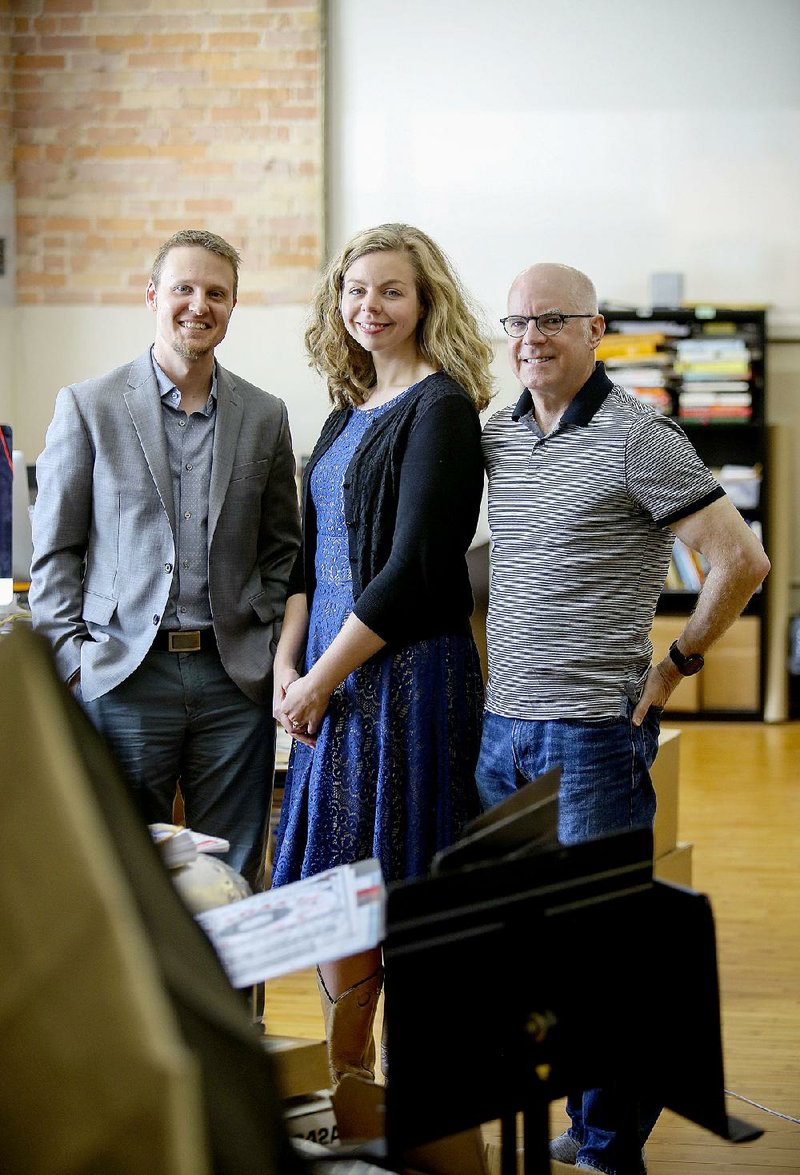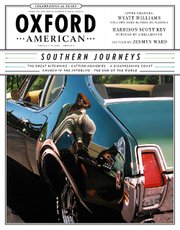The Oxford American magazine is celebrating its 25th anniversary this year, and in that quarter century the feisty Little Rock-based literary quarterly has weathered shutdowns, relocations, the firing of its founder, an embezzlement scheme, crippling debt and the wrath of that most nonliterary of outfits, the Internal Revenue Service.
And if magazines could talk, the OA would probably say, in a defiant drawl, "That all you got?"
Because through all the turmoil, the Oxford American persevered, serving as a bastion of Southern letters, photography and art, publishing work by writers like -- deep breath -- Barry Hannah, John Grisham, Jill McCorkle, Richard Ford, Nikki Finney, Charles Portis, Joy Williams, John Jeremiah Sullivan, Larry Brown and Donna Tartt, to name but a few.
The OA has won four National Magazine Awards, including one for general excellence in 2016. The fiction and journalism from its pages have been featured in The Best American Essays, The Best American Travel Writing, The Best American Short Stories and The Best American Mystery Stories. Pieces from the magazine have also won the O. Henry Prize and the Pushcart Prize.
"It is just a joy of a magazine, and it has been for a long time," says David Remnick, Pulitzer Prize winner and editor of The New Yorker. "It is so full of personality and surprise and obsession."
Ron Charles of The Washington Post praised the silver anniversary issue that was published in March, writing "here's to the next 25 years of great writing and striking photography from a tough magazine that refuses to fade away."
Over its two-plus decades, imploding spectacularly seemed more a possibility than fading away.
WELCOME TO ARKANSAS
The Oxford part of the magazine's name is Oxford, Miss., where California native Marc Smirnoff was working at the famed Square Books when he decided that what he really wanted to do was create a Southern literary magazine. The first issue, published in March 1992, featured work from Hannah, Ford, Roy Blount Jr., Lewis Nordan, John Updike and others.
"The Oxford American is dirt poor. But spirited," Smirnoff wrote in his grandiose and daring Declaration of Intent in that debut. "And we are inclined to break cowardly and domineering edicts for a cause we believe in."
Early editions featured "Rose of Lebanon," a previously unpublished William Faulkner story (Issue 7); Hannah's report from a Louisiana leper colony (Issue 9); a feature on Arkansas artist Donald Roller Wilson (Issue 15); and 1997's first music edition (Issue 17).
The OA was hailed by some as the South's answer to The New Yorker.
But money -- specifically the lack thereof -- was always a problem, and subscribers were never sure if the then-bi-monthly would actually show up. In the late '90s, Oxford-based best-selling author John Grisham, whose books Smirnoff edited, stepped in as publisher, and his 2000 novel, A Painted House, was excerpted in the magazine.
By 2002, though, publication had ceased. In 2003, the magazine was resurrected by investors and moved to Little Rock. Failing ad sales and debt nearly sank it again before it was brought under the aegis of the University of Central Arkansas, became a nonprofit and moved its offices to Conway in 2004. The magazine now operates "in alliance" with the college, according to its masthead.
In 2009 the OA's office manager, Vicki Renae Maxwell, pleaded guilty to theft of property and second-degree forgery after an investigation into money that had not been paid to creditors. She was sentenced to 90 days in jail and ordered to repay almost $100,000 in restitution to the magazine. When it looked like the magazine would shutter once again because of $57,000 owed to the IRS after the theft, an anonymous UCA alumnus donated $100,000 to cover that and other debts.
And in 2012, Smirnoff and his girlfriend, managing editor Carol Ann Fitzgerald, were sacked by the magazine's board of directors after allegations of sexual harassment. He was replaced by Roger Hodge.
It's the kind of history that would make a good story for a magazine.
A LIFE-CHANGER
Current Editor Eliza Borne, a 30-year-old Little Rock native, first discovered the OA via the 2003 music issue, the one with Esther Phillips on the cover.
"It just changed my life to learn that a magazine like this was being made right in my backyard," says Borne in a conference room at the magazine's bright, airy office on south Main Street in Little Rock -- above the old Juanita's restaurant. The operation was moved there from UCA in 2015, although there is still a satellite office at the school. The 2016 general excellence award, a copper-colored modern sculpture by Alexander Calder, sits on a coffee table and large prints of past covers lean against exposed brick walls.
Borne, a graduate of Little Rock Central High School who received her degree in English from Wellesley College, was an OA intern in 2006. She was chosen by Hodge to be associate editor in 2013 after a stint at Nashville's Bookpage and became just the third editor in the magazine's history after Hodge left in 2015.
Senior Editor Jay Jennings is another Little Rock native with a spot on the OA masthead. The 59-year-old writer and editor has worked at Sports Illustrated and Tennis and is the author of Carry the Rock: Race, Football and the Soul of an American City, about the Central High football team 50 years after the 1957 integration crisis. Jennings also edited Escape Velocity: A Charles Portis Miscellany, the much-lauded gathering of the beloved Arkansas author's essays and other writing.
"As a person who has worked for New York magazines for the past 20 years, I can say Eliza is the equal of any editor I've worked with," he says. "And I feel so lucky that this place, where I can come and do what I love, is just five blocks away from where I live and in my hometown."
The magazine receives annual support of about $70,000 for maintenance and operations from UCA, says Terry Wright, dean of the school's College of Fine Arts and Communication. With grants from the likes of the National Endowment for the Arts and ad sales, the OA pays 10 employees and five contractors working on each edition. The magazine has about 13,500 subscribers and averages around 9,000 single-copy sales per issue, Borne says.
The usual print run doubles for the ever-popular music issue.
"It's my favorite magazine day of the year," Remnick says of the day his music issue arrives.
DESIGN AND DIVERSITY
Printed by Little Rock's Democrat Printing and Lithographing (Jennings drove a truck for them when he was in college), and designed by art director Tom Martin of Memphis, the magazine's current look is one of clean lines and ample breathing room for its tasteful display of photography and art, a handsome balance of white space, text and images.
"We're very deliberate about the order of the magazine," Borne says. "It's a curated experience, to be read from beginning to end."
A typical issue features shorter pieces under the Points South banner at the front of the book, with poetry and longer pieces following. It is illustrated throughout by carefully chosen art and photographs.
"A Magazine of the South," reads text at the top of each issue, whatever the South happens to mean.
"One thing you will quickly learn if you spend time with our issues is we really do not like to define the South," Borne says.
The OA has recently published stories about an ex-junkie transgender woman living on the Texas-Mexico border; an excerpt from Sing, Unburied, Sing, the coming novel from National Book Award winner Jesmyn Ward; Nikky Finney's epic poem The Battle of and for the Black Face Boy; longtime food columnist John T. Edge's eye-opening collaborative piece on cultural appropriation with Nigerian-born New Orleans chef Tunde Wey; and Zandria F. Robinson's essay "Listening for the Country," a 2017 National Magazine Award finalist.
"We're always thinking of how to express the diversity of the South in a way that doesn't rely on stereotypes, and that comes from finding stories that people are really passionate about," Jennings says.
"It's important to us that we have people who live here telling their stories in their voices," Borne adds. "We also like to surprise people. We do have the sense that people from outside the South who haven't spent time here may have a certain view of what people who live here are like."
SOMA
The relationship with UCA has proved beneficial. Not only do UCA's creative writing students have a chance to intern at the magazine, but music programs held at South on Main, the restaurant-concert venue housed next door to the magazine, allow music students to get up close and personal with visiting jazz musicians during the magazine's Jazz Concert Series.
"The internships are just wonderful," Wright says. "The OA's internships are highly competitive, and this is not an internship where you just get coffee. You're working on the magazine."
South on Main came about when former publisher and then-UCA vice president of communications Warwick Sabin wanted to find a home for functions the magazine was hosting in New Orleans, Nashville, Atlanta and other Southern locales.
"The brand of the Oxford American is associated with the best of Southern culture, and that seemed like an asset we could leverage," says Sabin, who currently serves as District 33 Democratic representative to the Arkansas Legislature. "These events involved not just literary readings but concerts, art exhibitions and, always, food, because food is such an important element of Southern culture. They were a way we could connect with our readers and bring in new readers."
As the events grew, Sabin came up with the idea of a fixed location on the magazine's home turf.
In 2012 he received a $290,000 ArtPlace grant, which was used to renovate the space that now houses South on Main. The venue isn't owned by the magazine, rather, the OA has an operating agreement with Matt and Amy Bell, who own and manage the restaurant, serving up unique twists on Southern cuisine.
"[South on Main] has planted a flag in this community where people can come and interact with the OA in a way that's more powerful, maybe, than getting the magazine in your mailbox," says Ryan Harris, the magazine's executive director. Harris, 33, managed the nonprofit Sheldon Concert Hall in St. Louis before moving to Arkansas and meeting Sabin, who picked him to help get the South on Main programming rolling in 2013. "It's allowed us to build relationships in the community, which helps with fundraising and with sustaining the organization."
Along with the jazz series, the OA hosts concerts under the Americana and Archetypes & Troubadors monikers. During the 2016-2017 season, acts like Amy Helm and the Handsome Strangers, Jim Lauderdale, John Fullbright and the McCrary Sisters performed. Rodney Crowell, Parker Millsap, Theo Croker Quintet, The Secret Sisters and Lindi Ortega are among those appearing in the new season, which begins in August.
SOUTHERN STORIES
The summer edition, with its special section devoted to Southern Journeys, will hit newsstands and mailboxes early next month. Among its pages are Anne Gisleson's "The Beautiful Hunt" about the effects of opioid abuse on her family; John O'Connor's "Georgetown One Stop," about White River catfish; frequent contributor Jamie Quatro's piece on former houses of worship, with photographs by Maude Schuyler Clay; and new fiction from Van Diamondfinger and Gothataone Moeng.
This year's music issue, with its accompanying CD, will be available in late November, Borne says.
Along with its handy archives, special galleries and selections from the print version, the magazine's website, oxfordamerican.com, recently premiered The By and By, a weekly feature in partnership with Duke University's Center for Documentary Studies, with dispatches from musician Tift Merritt and writers Sandra Gutierrez, Matthew Neill Null, Will Stephenson and Ronni Lundy.
It's just another way the scrappy magazine with more lives than a roomful of cats continues to illuminate the Southern gestalt.
"We're telling stories from Miami, Appalachia, the Ozarks, the U.S.-Mexico border," Borne says. "I feel like it's very important, what we're doing, and I think our mission is more vital than it's ever been."
Concert series
The Oxford American's 2017-2018 Concert Series at South on Main (with one exception) kicks off Aug. 26 and runs through May 10. For times and ticket pricing, visit metrotix.com or call (800) 293-5949.
AMERICANA
Rodney Crowell, Aug. 26
Parker Millsap, Oct. 5
Lindi Ortega, Feb. 15
Bonnie Bishop, May 3
ARCHETYPES & TROUBADOURS
The Secret Sisters, Sept. 21
Fantastic Negrito, Nov. 9
Bhi Bhiman, March 15
Birds of Chicago, May 10
JAZZ
Theo Croker Quintet, Sept. 7
No Tears Suite, at Little Rock Central High School, Sept. 23
The Latin Jazz All Stars, Dec. 7
Catherine Russell, Feb. 1
Melissa Aldana Quartet, April 5
-- Sean Clancy
Style on 05/28/2017




